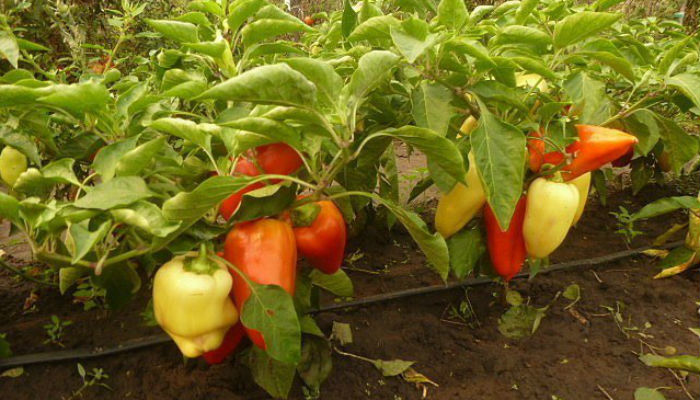 It is rare that a gardener, having seen colorful bags with seeds of various peppers in a store, is restrained not to buy some sort of variety or hybrid again.
It is rare that a gardener, having seen colorful bags with seeds of various peppers in a store, is restrained not to buy some sort of variety or hybrid again.
Today the choice is very large, but you need to know what characteristics of peppers to pay attention to, so that the work is not wasted, and an excellent harvest was obtained.
Among the favorites, many have undersized peppers, which may not be as productive as their tall counterparts, but more unpretentious in their care. About them will be our story.
Content
Description and characteristics of undersized varieties of pepper
Just like tomatoes, peppers are divided not only by maturity, shape and color of the fruit, but also by the height of the plants. Determinant (undersized) varieties and hybrids of pepper are excellent options for those who are just mastering the basics of gardening, as well as for summer residents of the northern regions. Although the "kids" are successfully and willingly grown in all regions of Russia, receiving early harvests of delicious juicy fruits.
Peppers children (determinant) are not very tall, and in a certain phase of their development they stop growing altogether. Usually the height of the bushes is 40-60 cm, a limited number of ovaries are formed on the plant. Many peppers of this group are standard, with a compact habit, and not large.
The properties
For the most part, determinant peppers are early-ripening varieties and hybrids (and some even ultra-ripening ones), which have a variety of fruits in shape, size and weight. This category includes peppers, the first fruits of which can be removed after 90-105 days (for example, Red Square), as well as mid-season varieties and hybrids.
The shapes and sizes of sweet pepper fruits are very different, and in the group of determinant plants you can find “cubes”, prisms, cones, “bocata”, perfectly flat or ribbed fruits.
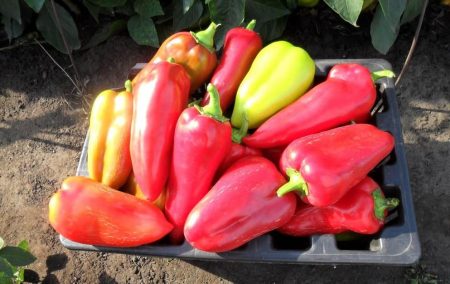
In a state of technical maturity, all peppers have a green color (saturation may be different), but already at the time of full maturity (biological maturity) you can see the full color gamut: red, scarlet, orange, yellow, cream and even dark purple.
There are varieties of short-skinned peppers with thick-skinned fruits, which are great for making lecho, stuffing. Varieties with thin pericarp have been developed, which are usually used fresh and for conservation. Productivity is also different, but do not forget that in many respects this indicator depends on proper care.
Due to the early ripening and low height of the bush, fruits on these peppers are formed quickly. On average, from most varieties, the first fruits can be removed after 100-110 days (in the phase of technical ripeness), having spent a minimum of effort on grooming and feeding. With tall peppers, this option will not work, because they need to start gaining growth, and the first fruits will return later.
Of course, in terms of taste, the fruits of varieties and hybrids of determinant peppers are probably inferior to indets. But, firstly, today many excellent varieties of peppers, fruit hybrids that are distinguished by excellent taste qualities are bred. Secondly, on the site (in the beds, in the greenhouse) it is recommended to plant different varieties of peppers (undersized, indices) in order to get a crop throughout the season.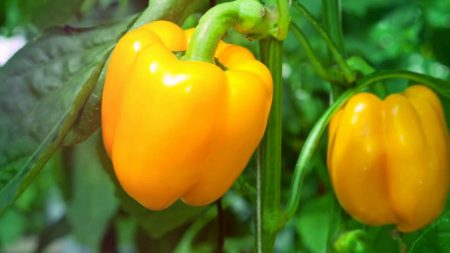
The advantages of undersized varieties
Pepper is thermophilic and rather capricious, and although its agricultural technology is not particularly complicated, not everyone succeeds in obtaining a good crop in the harsh conditions of many Russian regions. Low-growing varieties are good in that they require a minimum of care, while they do not need to form bushes. For many gardeners, it is the formation of plants that causes certain difficulties, and when growing indeterminate varieties, all this “science” must be known.
With determinant peppers is much simpler, since their low bushes below have a non-branching stem, and this greatly facilitates care. The advantages also include:
- compactness of plants;
- the ability to plant a large number of bushes on one square meter;
- cold resistance;
- disease resistance.
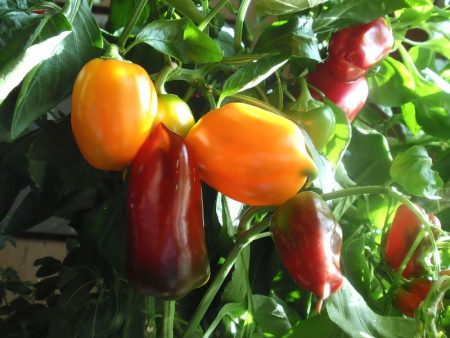
The main distinguishing feature of these peppers is the small height of the plants, which makes it possible to grow them in open ground, various tunnels, greenhouses. Today, selection in a group of peppers of a determinant type is carried out with an emphasis on obtaining large-fruited fruits, a standardized type of bushes. Also, breeders are trying to expand the range of colors and fruits of such peppers, and, of course, increase productivity.
The variety and hybrids of stunted peppers with large thick-walled fruits, a large number of fruits on the bush are no longer surprised. Due to the peculiarities of the plants themselves, it is impossible to get a crop from such peppers, like indets (the height of the bush makes itself felt), since the brushes are smaller, the fruiting period is shorter.
But on the other hand, such varieties allow you to get tasty fruits in a very short time (which is important for Russian gardeners) in the conditions of a short summer. Many summer residents have very small areas, but I want to grow a lot. And here compact determinant varieties of sweet pepper will be an excellent choice, all the more so for them you can always build shelter right on the bed (arcs with a film or non-woven material).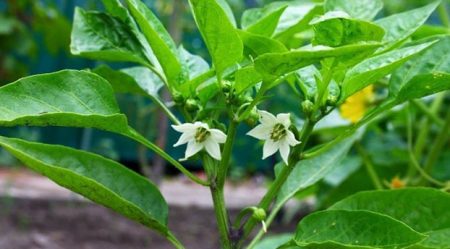
Hybrids and varieties of stunted sweet pepper
In one review it is impossible to describe sweet peppers of all hybrids and varieties of a determinant species, so we note the most popular of them. They showed themselves well in different regions, differ in productivity, delicious fruits. Do not forget that the characteristics of a particular variety or hybrid declared in the descriptions will manifest themselves only with competent and proper care of the crop.
Eroshka
The variety with the mischievous name Eroshka will please with large "egg capsules" fruits of orange-red color. His bush is very small, usually no more than 40 cm, medium-leaved.
It does not need formation and pinching; during the ripening period, a garter is necessary. This is a standard grade, very compact.
On one plant with good care, you can get up to 16 fruits. Peppers can be removed after 95 days (technical maturity), after about 135 days, full ripening occurs.
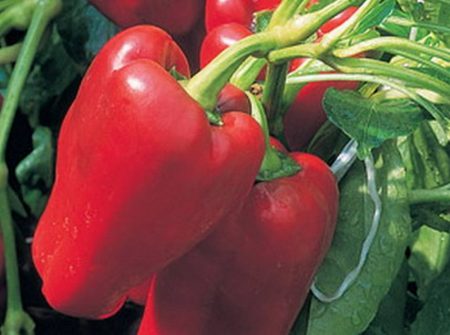 Eroshka gives better crops with a tight planting, while up to 10-12 plants can be planted per square meter.
Eroshka gives better crops with a tight planting, while up to 10-12 plants can be planted per square meter.
Many gardeners grow it in large greenhouses, planting it between tall peppers or tomatoes. But with this option, special attention should be paid to top dressing.
Eroshka’s fruits are beautiful, weighing an average of 150 grams, some of which are up to 180 grams. The taste is great. Commonly used for salads.
Sveta
Pepper of Light is a classic sample of sweet pepper with fruits shaped like long cones. Their mass reaches no more than 80 grams, the skin is dense, with gloss. At the time of full ripening, peppers acquire a bright orange-yellow color.
The taste is very good, for which many gardeners appreciate it.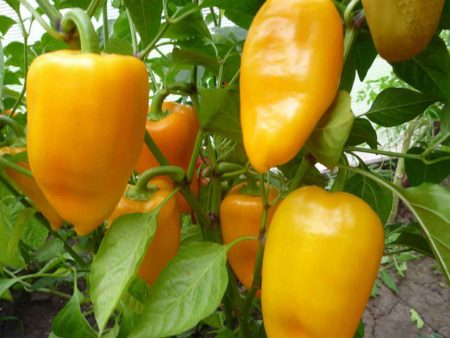
The variety belongs to determinant peppers, grows to about 60 cm. The bush is compact, there are few leaves.
This variety of pepper is recommended to be grown in film shelters, it also bears fruit very well on ridges. Suitable for regions with a short summer, manages to quickly and amicably give the crop.Feature of the variety: it is very resistant to a number of viral diseases of pepper.
Fakir
Many summer residents appreciated the undersized grade of pepper Fakir. This is an early variety, the first small fruits can be removed already 90-95 days after emergence. Fakir peppers are modest in weight - up to about 65 grams, but they are tasty and juicy.
The variety is low, the bushes usually grow no more than half a meter, middle leafy. Fruits are drooping, narrow and long cones. Peppers in a state of technical maturity are yellow-green; when fully ripened, they are bright red. Pericarpius - up to 4 mm. The peculiarity of the Fakir variety is a shortened ripening period from technical to biological ripeness of the fruit. The taste of peppers is excellent.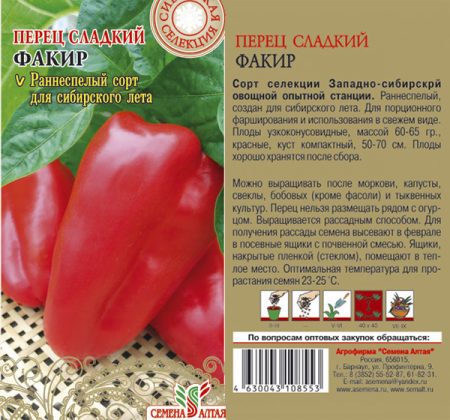
Currently, breeders have bred varieties of Fakira with fruits of other colors: yellow, dark brown. It is used in all types of preservation, it is also suitable for salads, all kinds of slices, for the preparation of side dishes.
Agapovsky
This variety of pepper can be called a "veteran", as it was bred for a long time and all these years has not lost ground. It is appreciated for productivity, unpretentiousness, fragrant and tasty fruits.
Agapovsky has a low (up to 70 cm) bush, which makes it possible to grow it on ridges under arcs. The plant is highly leafy, leaf blades are large, saturated green.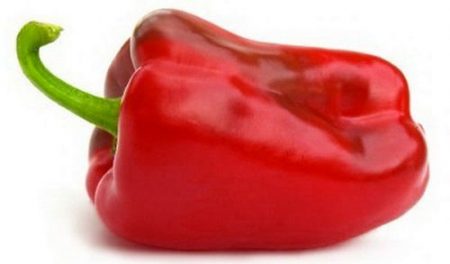
The large, up to 120 grams of the drooping fruits of the “prism” resemble their bells. Peppers are red, the skin is very dense, with gloss. The length of the peppers is about 12-15 cm, the pericarp is up to 7 mm. There is a slight ribbing, the peduncle is slightly depressed. Feature of the Agapovsky variety: excellent taste of peppers, very pleasant and strong aroma of fruits.
The variety is resistant to many diseases of pepper, to temperature changes, does not reduce productivity in low light. On average, up to 10 kg of fruit can be removed from one square meter of plantings.
Albatross
Very good yields on a hybrid of pepper Albatross F1, bred by Dutch breeders. A short pepper (and its height usually reaches 60 cm) will surprise with a powerful stocky stalk, strong foliage. It gives good results on ridges, in tunnels and greenhouses.
Fruits grow up to 120 grams in weight, form in the form of cones, wall thickness - up to 6-7 mm. Peppers are interesting in color - at first whitish-yellow, then a reddish hue begins to prevail in it.
These peppers are distinguished by very high palatability, it is not without reason that they are recommended to be used fresh to preserve all vitamins as much as possible. Hybrid Albatross is valuable for its keeping quality and transportability.
Fox
The originator of the hybrid of chanterelle pepper is the well-known agricultural company "Gavrish". Determinant pepper grows to 60 cm, a small bush. Small in size and weight and the fruits of Chanterelles - bright orange "cones", 25-40 grams. But these “crumbs” have a very pleasant taste with a spicy aroma of spice, somewhat unusual for this type of pepper. The pericarp of the fruit is up to 6 mm, the walls are fleshy, juicy. Pepper peel is smooth, glossy.
For the plant does not require the formation of a bush, which greatly simplifies the care. Garter is needed to hold the fruit. From one bush varieties can be removed up to 1-1.2 kg of peppers.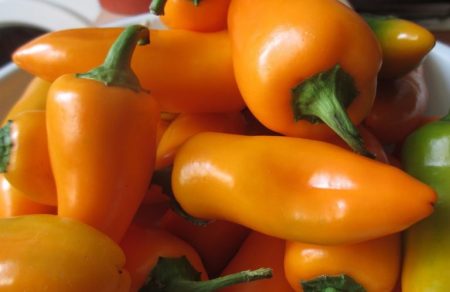
Hybrid Chanterelle is resistant to various diseases, bears fruit well in open ground, and can be grown in tight plantings.
Boneta
Another determinant pepper, Boneta, is famous for its excellent taste. Its fruits in creamy ripeness have cream color, in biological - red-orange.
The bush is low, about half a meter, few leaves. It grows well in greenhouses, on ridges under arcs. The Boneta variety tolerates a slight blackout, is resistant to temperature extremes.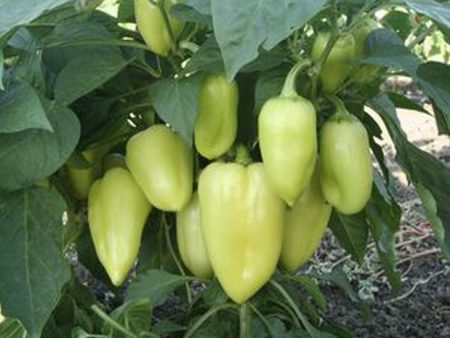
Peppers are prismatic, fleshy, large, weighing up to 300-400 grams. Boneta variety belongs to thick-walled peppers, pericarp - up to 7 mm. The fruits are suitable for stuffing, cooking lecho, various first and second courses. Boneta peppers are also fresh.
In terms of ripening - one of the early varieties, it takes about 90 days from germination to harvesting the first fruits. From one square meter is collected (subject to all agricultural practices) up to 3.1-3.3 kg of peppers.
Timoshka
You can harvest the fruits of the Timoshka variety after 100 days, so if you are interested in early varieties, we recommend that you pay attention to this pepper.
Large, up to 150 grams of fruits grow on a bush up to 70-80 cm tall. Timoshka's “cones” are distinguished by their juiciness, thick walls (6-8 mm), and excellent taste. The peel of the drooping fruits is dense, with a strong gloss, the color is dark red (at the stage of biological maturity). Fruits usually have two nests, few seeds.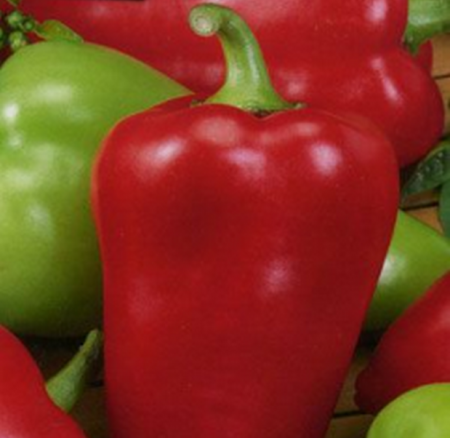
This variety is grown by many gardeners in the Urals, in Siberia, as Timoshka is famous for the friendly return of the crop, high taste qualities of the fruits. Yields are also very good, with up to 4-4.5 kg of peppers removed from one square meter.
Gemini
Gemini's Dutch determinant pepper belongs to F1 hybrids, so you cannot get your seeds from it. And many gardeners like it, so if you want to grow Gemini every season, you will have to take care of buying seeds in advance.
The hybrid is fruitful, unpretentious, with tasty juicy fruits. The bush grows low, up to 60 cm, leafiness is average, leaf blades are dark green, wrinkled. “Cubes” of fruits in technical maturity have a deep green saturated hue, in biological maturity they become bright yellow. The mass of peppers is about 200 grams, in greenhouses you can grow fruits up to 300 grams.
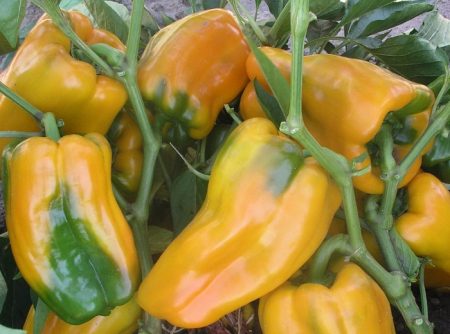 The peduncle is slightly depressed, the skin is dense, glossy. Gemini's peppers are aligned, very beautiful. Used for lecho, stuffing, salads, various culinary dishes.
The peduncle is slightly depressed, the skin is dense, glossy. Gemini's peppers are aligned, very beautiful. Used for lecho, stuffing, salads, various culinary dishes.
It is recommended to plant no more than 3-4 plants per square meter, which is due to the hybrid's demanding for good nutrition. Harvest gives together, the first fruits can be removed after 90-100 days. On one plant, up to 10 fruits are simultaneously formed. In the context of risky farming regions, it is recommended to grow the Gemini hybrid indoors.
Ilya Muromets
Real strong men and heroes are the fruits of pepper Ilya Muromets, a variety that fully lives up to its name. This is a mid-season pepper, about 125 days pass before harvesting the first fruits.
They grow it in greenhouses, hotbeds, under arcs in the ridges and right under the open sky. The bush is low, standard. The shape of peppers resembles small prisms, the mass of each fruit is up to 180-200 grams. In closed ground, with proper agricultural technology, fruits grow to 300 grams. Peppers have a smooth glossy peel, pericarp - up to 5 mm. The pulp is very juicy, tasty, but the aroma is weakly expressed.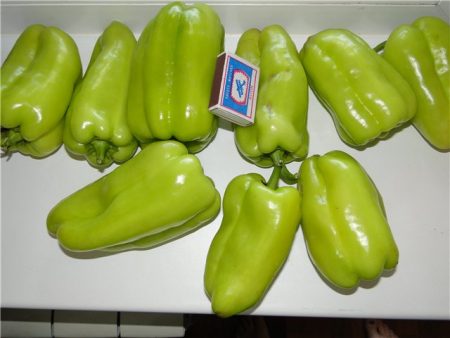
The variety is characterized by productivity, it is also quite unpretentious, but with all the techniques and good care, productivity indicators increase. On average, up to 5 kg of fruits are harvested from one square meter.
The peculiarity of the variety: disease resistance, especially the resistance of pepper Ilya Muromets to verticillosis.
Reviews
Elena, Vologda Oblast
I really wanted to try to grow yellow pepper. Gemini advised me, I’ve been growing it for the third year and I’m not overjoyed! Pepper is good for everyone: tasty, juicy, fragrant. Delicious in marinade, in lecho. Stuffed peppers in our family do not eat very well, but they love lecho very much, so I only take Gemini for him.
Elina, St. Petersburg
I bought chanterelle pepper seeds, I liked the photo on the bag. The bush grew small, was planted in my greenhouse, planted in May. The first fruits went in late July, and very quickly they began to turn from green to orange.The plant had about 10 fruits, juicy, spicy.
For large quantities, this variety is not suitable, but I used it in salads, in rolls with other varieties. It proved to be good in storage, in the refrigerator in the drawer below it does not fade for a very long time.
Katerina, Ekaterinburg
I chose fakir pepper because of its early dates. The seeds were from the company “Search, but after three months (as the manufacturer promised), the fruits still could not be removed. It may be due to our climate, but other varieties manage to give me a more generous crop.
But to taste this variety is simply magnificent! And the fruits are beautiful - long, fleshy when ripen - dark red. For conservation, this variety is ideal! The banks look very nice, and very tasty. I also made stuffed, the form is very comfortable. I recommend that only the ripening dates should be taken into account so that the fruits have time to ripen.




 Calorie pepper stuffed with meat and rice - BZHU per 100 grams
Calorie pepper stuffed with meat and rice - BZHU per 100 grams Gorky pepper - the best varieties for open ground
Gorky pepper - the best varieties for open ground Hot pepper seeds - the best varieties for open ground and reviews
Hot pepper seeds - the best varieties for open ground and reviews Capsicum tincture for hair - how to use and reviews
Capsicum tincture for hair - how to use and reviews